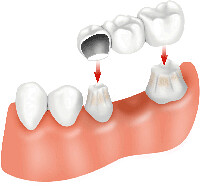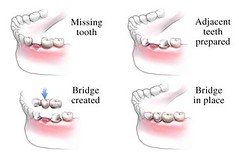 In the olden days, when people lost their teeth or had missing teeth due to genetic reasons, they just had to live with their conditions. However, nowadays, thanks to modern science and the many developments and innovations that have been made in dentistry, individuals no longer have to suffer their entire lives with smiles that they aren’t comfortable with. The number of people who suffer from missing teeth for whatever reason is much greater than many people realize. Fortunately, there are a variety of dental procedures available to address this dental issue, one of which is known as cantilever bridges.
In the olden days, when people lost their teeth or had missing teeth due to genetic reasons, they just had to live with their conditions. However, nowadays, thanks to modern science and the many developments and innovations that have been made in dentistry, individuals no longer have to suffer their entire lives with smiles that they aren’t comfortable with. The number of people who suffer from missing teeth for whatever reason is much greater than many people realize. Fortunately, there are a variety of dental procedures available to address this dental issue, one of which is known as cantilever bridges.
What Are Cantilever Bridges?
Cantilever bridges are a type of dental bridge that is used in special cases when the bridge cannot be placed between two abutments. This basically means that the patient doesn’t have teeth on both sides of the gap of missing teeth to which to affix the dental bridge. Most dental bridges are placed between two teeth by anchoring them between the two teeth to create the bridge that essentially bridges the gap where there are missing teeth. With a cantilever bridge, though, instead of the pontic being located inside abutting teeth, it is located outside the abutment of teeth since there is nothing on the other side to anchor it to.
Cases Where Cantilever Bridges Might Be Used
There are various scenarios where it might be best to use cantilever bridges over traditional ones. Perhaps the biggest reason is when there simply is no other tooth on the other side of the gap to connect the abutment to, but there are a couple of other times when cantilever bridges might be the best choice as well. For instance, another instance of when a cantilever bridge might be best is when it wouldn’t look good to have a traditional dental bridge for aesthetic reasons, such as when a bridge is being constructed in the front of the mouth where individuals smile. Finally, if one of the teeth surrounding the bridge is already supporting another dental device, then the dentist will probably recommend a cantilever bridge in order to avoid the possibility of damaging the other device and putting too much pressure on the said tooth.
Maintaining Cantilever Bridges
 The process for maintaining cantilever bridges is basically the same as that of maintaining regular types of dental brides. However, individuals should take care not to put too much pressure on the areas where they have cantilever bridges are because they could possibly become damaged or break. For instance, avoid chewing on extremely sticky foods like caramel, and abstain from grinding teeth together. Additionally, patients should brush their teeth after every meal to reduce the likelihood of food becoming lodged in between the bridge, which could eventually lead to a serious gum infection. Brushing with a soft toothbrush is also recommended since it won’t be as rough on the bridge as harder toothbrushes would. Of course, patients should also floss at least once daily, and they should receive professional dental cleanings every six months, during which time their dentists can check the state of the bridges to determine whether any adjustments or fixes need to be made before any minor problems turn into major ones.
The process for maintaining cantilever bridges is basically the same as that of maintaining regular types of dental brides. However, individuals should take care not to put too much pressure on the areas where they have cantilever bridges are because they could possibly become damaged or break. For instance, avoid chewing on extremely sticky foods like caramel, and abstain from grinding teeth together. Additionally, patients should brush their teeth after every meal to reduce the likelihood of food becoming lodged in between the bridge, which could eventually lead to a serious gum infection. Brushing with a soft toothbrush is also recommended since it won’t be as rough on the bridge as harder toothbrushes would. Of course, patients should also floss at least once daily, and they should receive professional dental cleanings every six months, during which time their dentists can check the state of the bridges to determine whether any adjustments or fixes need to be made before any minor problems turn into major ones.
References:
American Dental Association
211 East Chicago Ave.
Chicago, Illinois 60611-2678
312-440-2500
http://www.ada.org
Colgate
300 Park Avenue
New York, New York 10022
212-310-2000
http://www.colgate.com
Images:
https://farm9.staticflickr.com/8058/8240186041_ecb1dc25b6_m.jpg
https://farm8.staticflickr.com/7418/12946443063_bef7ecac0c_m.jpg